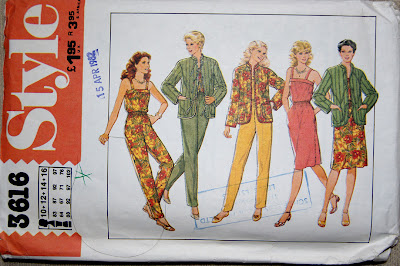And it opens!
Isn't it pretty? It's made by Owl Loves Panda, who also has lots of other pretty costume jewellery bits - check them out. (I was tempted by the colourful cameo necklaces, too!)
I'm not generally into gold-toned jewellery, I'm more into silver, but this was too cute to pass up. I think part of the reason I avoid gold is because I don't think it suits me - wearing it, I become all a bit too yellow.
Which brings me to the Singer Sewing Book's colour charts from last week. You had some great responses in the comments - quite a few of us are, perhaps understandably, a bit cynical about such things. Do they ever really work? Are they too generic? Let's see ...
Here is my colouring:
I'm not wearing make-up, so you can see my skin tone without powder or blusher and to get as accurate a picture as possible of my eye-colour. My eyes are a bit of a weird colour and that doesn't show too well in photos - I think of them as being a similar colour to olives or olive oil.
When I worked in an art shop and had to straighten up all the tubes of artist's watercolours, I thought Windsor and Newton's green-gold was a close match:
Though there it looks rather more yellow than in the tube.
What I mean to say is that my eyes are hazel, not quite green, not quite brown. But "hazel eyes" can mean a hundred, even a thousand, different things, and even in the same person - when I'm unwell, they look more greenish, in the light of the setting sun they look more golden, when I wear purple shades of eyeshadow, they look more green. My boyfriend's eyes are hazel, too, but his are lighter, more green and even have flashes of light blue.
My skin's probably a bit more yellow-ish than it looks in the photo and my hair is a very, very dark brown, nearly black at the roots.
So, what colours does Mary Brooks Picken say I should wear? And is she right?!
Well, the first things she says that definitely applies to me is:
An olive complexion may lose all its blush tones and appear only sallow when it is matched with a dress of drab or mustard brown colour.I don't wear yellow. Of any shade. Not next to my face, anyway (I have a yellow bag). MBP is absolutely right here - if I were to wear a mustard-y colour, I would just look yellow (or like I'm from The Simpsons, as I always say!). One point to Gryffindor ... I mean, MBP!
As for the colour-fans themselves, I (black-brown hair, hazel eyes, light olive skin) probably fall into the "Dark Brunette Type":
In the description, she says that "sallow skin brunettes" (me!) "should avoid yellowish greens or orange." Well, she's half right. Yellow-toned greens are a no-go for me (which I learnt when trying on a pretty knitted cardigan as a teenager - that was a nasty surprise!), but certain shades of orange (burnt orange, for instance) are fine. Only half a point to MBP, this time.
I think "high colouring" means reddish cheeks or skin prone to blushing - is that right? In which case, that might be a lucky thing for you as she claims it means you can wear almost any colour, though I would have imagined that green, being the complementary colour to red, would make that redness stand out all the more. I can't grade MBP on this one, though, as I don't have that colouring and can't say whether it's true or not - do you know?
As for the colours on the fan: the reds, purples, blues, greens and greys do tend to suit me, though she's missed out a coral-pink and darker, more graphite greys and turquoise and teals, which are colours that suit me very well (apparently). But, in all, I'd say MBP's doing pretty well again, here.
In fact, I'd say MBP has done pretty well with colour advice for me overall - I'm pleasantly surprised! Often colour charts suggest that I should wear 'warm' colours, but I don't generally like them (in particular, I hate brown, unless its leather). I think one of the benefits of her fans is that there are cooler and warmer colours suggested for every type, which allows you to choose colours that you like from within those that suit you.
What about your colouring? I'd love to hear whether or not the fan for your colour "type" works for you - let me know in the comments!



























